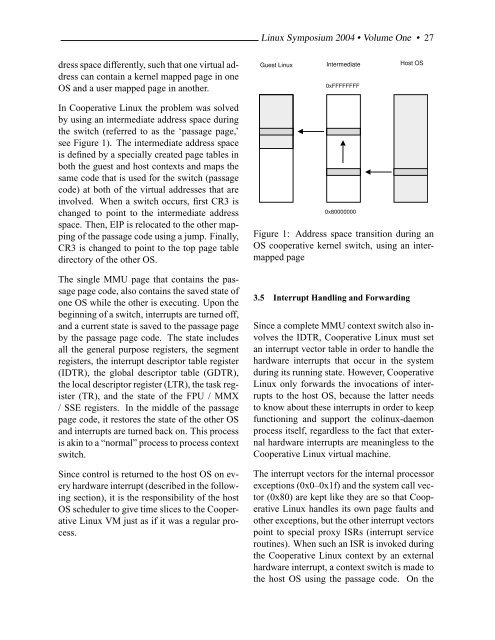You also want an ePaper? Increase the reach of your titles
YUMPU automatically turns print PDFs into web optimized ePapers that Google loves.
<strong>Linux</strong> Symposium 2004 • Volume <strong>One</strong> • 27<br />
dress space differently, such that one virtual address<br />
can contain a kernel mapped page in one<br />
OS and a user mapped page in another.<br />
Guest <strong>Linux</strong><br />
Intermediate<br />
0xFFFFFFFF<br />
Host OS<br />
In Cooperative <strong>Linux</strong> the problem was solved<br />
by using an intermediate address space during<br />
the switch (referred to as the ‘passage page,’<br />
see Figure 1). <strong>The</strong> intermediate address space<br />
is defined by a specially created page tables in<br />
both the guest and host contexts and maps the<br />
same code that is used for the switch (passage<br />
code) at both of the virtual addresses that are<br />
involved. When a switch occurs, first CR3 is<br />
changed to point to the intermediate address<br />
space. <strong>The</strong>n, EIP is relocated to the other mapping<br />
of the passage code using a jump. Finally,<br />
CR3 is changed to point to the top page table<br />
directory of the other OS.<br />
<strong>The</strong> single MMU page that contains the passage<br />
page code, also contains the saved state of<br />
one OS while the other is executing. Upon the<br />
beginning of a switch, interrupts are turned off,<br />
and a current state is saved to the passage page<br />
by the passage page code. <strong>The</strong> state includes<br />
all the general purpose registers, the segment<br />
registers, the interrupt descriptor table register<br />
(IDTR), the global descriptor table (GDTR),<br />
the local descriptor register (LTR), the task register<br />
(TR), and the state of the FPU / MMX<br />
/ SSE registers. In the middle of the passage<br />
page code, it restores the state of the other OS<br />
and interrupts are turned back on. This process<br />
is akin to a “normal” process to process context<br />
switch.<br />
Since control is returned to the host OS on every<br />
hardware interrupt (described in the following<br />
section), it is the responsibility of the host<br />
OS scheduler to give time slices to the Cooperative<br />
<strong>Linux</strong> VM just as if it was a regular process.<br />
0x80000000<br />
Figure 1: Address space transition during an<br />
OS cooperative kernel switch, using an intermapped<br />
page<br />
3.5 Interrupt Handling and Forwarding<br />
Since a complete MMU context switch also involves<br />
the IDTR, Cooperative <strong>Linux</strong> must set<br />
an interrupt vector table in order to handle the<br />
hardware interrupts that occur in the system<br />
during its running state. However, Cooperative<br />
<strong>Linux</strong> only forwards the invocations of interrupts<br />
to the host OS, because the latter needs<br />
to know about these interrupts in order to keep<br />
functioning and support the colinux-daemon<br />
process itself, regardless to the fact that external<br />
hardware interrupts are meaningless to the<br />
Cooperative <strong>Linux</strong> virtual machine.<br />
<strong>The</strong> interrupt vectors for the internal processor<br />
exceptions (0x0–0x1f) and the system call vector<br />
(0x80) are kept like they are so that Cooperative<br />
<strong>Linux</strong> handles its own page faults and<br />
other exceptions, but the other interrupt vectors<br />
point to special proxy ISRs (interrupt service<br />
routines). When such an ISR is invoked during<br />
the Cooperative <strong>Linux</strong> context by an external<br />
hardware interrupt, a context switch is made to<br />
the host OS using the passage code. On the

















